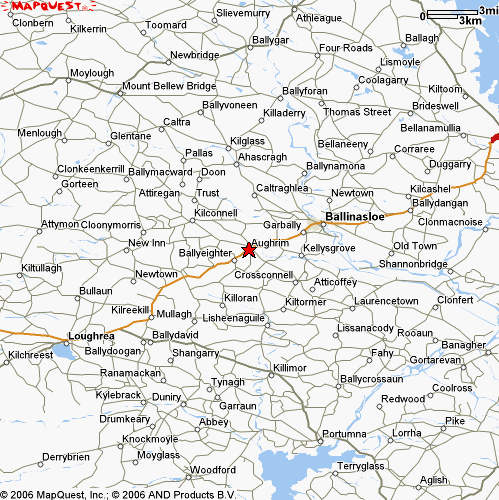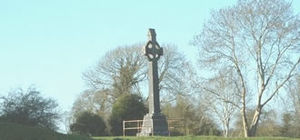Battle of Aughrim
(Taken from Wikipedia)
The Battle of Aughrim was the decisive battle of the Williamite war in Ireland. It was fought between the Jacobites and the forces of William III on 12 July 1691, near the village of Aughrim in County Galway.
The battle was the bloodiest ever fought on Irish soil – over 7,000 people were killed. It meant the effective end of Jacobitism in Ireland, although the city of Limerick held out until the autumn of 1691.
The Campaign
The Jacobite position in the summer of 1691 was a defensive one. In the previous year, they had retreated behind the River Shannon, which acted as an enormous moat around the province of Connacht, with strongholds at Sligo, Athlone and Limerick guarding its crossings. From this position, the Jacobites hoped to receive military aid from Louis XIV of France via the port towns and eventually be in a position to re-take the rest of Ireland.
 Godert de Ginkell, the Williamite's Dutch general, had breached this line of defence by crossing the Shannon at Athlone - taking the town after a bloody siege. St Ruth, the French Jacobite general moved too slowly to save Athlone, as he had to gather his troops from their quarters and raise new ones from rapparee bands and the levies of Irish landowners. Ginkel marched through Ballinasloe, on the main road towards Limerick and Galway, before he found his way blocked by St Ruth’s army at Aughrim on the 12th of July 1691. Both armies were about 20,000 men strong. St Ruth’s army was almost entirely Irish Catholic, whereas Ginkel were English, Scottish, Danish, Dutch and French Huguenot (members of William III’s League of Augsburg) and Ulster Protestants.
Godert de Ginkell, the Williamite's Dutch general, had breached this line of defence by crossing the Shannon at Athlone - taking the town after a bloody siege. St Ruth, the French Jacobite general moved too slowly to save Athlone, as he had to gather his troops from their quarters and raise new ones from rapparee bands and the levies of Irish landowners. Ginkel marched through Ballinasloe, on the main road towards Limerick and Galway, before he found his way blocked by St Ruth’s army at Aughrim on the 12th of July 1691. Both armies were about 20,000 men strong. St Ruth’s army was almost entirely Irish Catholic, whereas Ginkel were English, Scottish, Danish, Dutch and French Huguenot (members of William III’s League of Augsburg) and Ulster Protestants.
The Jacobite position at Aughrim was quite strong. St Ruth had drawn up his infantry along the crest of a ridge known as Kicommadan Hill. The hill was lined with small stone walls and hedgerows which marked the boundaries of farmer’s fields, but which could also be improved and then used as earthworks for the Jacobite infantry to shelter behind. The left of the position was bounded by a bog, through which there was only one causeway, which was overlooked by Aughrim village and a ruined castle. On the other, open, flank, St Ruth placed his best infantry and most of his cavalry under Patrick Sarsfield.
The battle
The battle started with Ginkel trying to assault the open flank of the Jacobite position with cavalry and infantry. This attack ground to a halt after determined Jacobite counter-attacks and the Williamites halted and dug in behind stakes driven into the ground to protect against cavalry. In the centre, the Williamite infantry under Hugh Mackay tried a frontal assault on the Jacobite infantry on Kilcommadan Hill. The Williamite troops, mainly English and Scots, had to take each line of trenches, only to find that the Irish had had fallen back and were firing at them from the next line. The Williamite infantry attempted three assaults, the first reached the furthest. Eventually, the final Williamite assault was driven back with heavy losses by cavalry and pursued into the bog, where more of them were killed or drowned. In the rout, the pursuing Jacobites manage to spike a battery of Williamite guns.
This left Ginkel with only one option, to try and force a way through the causeway on the Jacobite left. This should have been an impregnable position, with the attackers concentrated into a narrow lane and covered by the defenders of the castle there. However, the Irish troops there were short on ammunition. Mackay directed this fourth assault, consisting mainly of cavalry, in two groups - one along the causeway and one parallel to the south. The Jacobites stalled this attack with heavy fire from the castle, but then found that their reserve ammunition, which was British made, would not fit into the muzzles of their French supplied muskets. The Williamites then charged again with a reasonably fresh regiment of Anglo-dutch cavalry under Henri de Massue, faced with only weak musket fire they crossed the causeway and reached Aughrim village with few casualties. The castle quickly fell and the remaining Jacobite garrison was killed.
 St Ruth appeared to believe that the battle could be won and was heard to shout, "they are running, we will chase them back to the gates of Dublin". However, as he tried to rally his cavalry on the left to counter-attack and drive the Williamite horse back, he was decapitated by a cannon ball. At this point, the Jacobite position collapsed very quickly. Their horsemen, demoralised by the death of their commander, fled the battlefield, leaving the left flank open for the Williamites to funnel more troops into and envelope the Jacobite line. The Jacobites on the right, seeing the situation was hopeless, also began to melt away, although Sarsfield did try to organise a rearguard action. This left the Jacobite infantry on Killcommadan Hill completely exposed and surrounded. The Williamite cavalry slaughtered them as they tried to get away, many of them having thrown away their weapons in order to run faster. One eyewitness, George Story, said that bodies covered the Hill, and looked from a distance like a flock of sheep. To this day, this area is known as the "Bloody Hollow".
St Ruth appeared to believe that the battle could be won and was heard to shout, "they are running, we will chase them back to the gates of Dublin". However, as he tried to rally his cavalry on the left to counter-attack and drive the Williamite horse back, he was decapitated by a cannon ball. At this point, the Jacobite position collapsed very quickly. Their horsemen, demoralised by the death of their commander, fled the battlefield, leaving the left flank open for the Williamites to funnel more troops into and envelope the Jacobite line. The Jacobites on the right, seeing the situation was hopeless, also began to melt away, although Sarsfield did try to organise a rearguard action. This left the Jacobite infantry on Killcommadan Hill completely exposed and surrounded. The Williamite cavalry slaughtered them as they tried to get away, many of them having thrown away their weapons in order to run faster. One eyewitness, George Story, said that bodies covered the Hill, and looked from a distance like a flock of sheep. To this day, this area is known as the "Bloody Hollow".
Aftermath
Estimates of the two army’s losses vary. It is generally agreed that about 7000 men were killed at the battle. Most recent studies put the Williamite dead as high as 3000, with 4000 Jacobites killed. Many of the Jacobite dead were officers whom it was very difficult to replace. On top of that, another 4000 Jacobites either deserted or were taken prisoner. What was more, they had lost the better part of their equipment and supplies. For these reasons, Aughrim was the decisive battle of the Williamite war in Ireland. The city of Galway surrendered without a fight after the battle and the Jacobite's main army surrendered shortly afterwards at Limerick after a short siege. The battle according to one author, "seared into Irish consciousness", and became known in the Irish language tradition as Eachroim an air - "Aughrim of the slaughter". The contemporary Gaelic poet Seamus Dall wrote of the Irish dead, "It is at Aughrim of the slaughter where they are to found, their damp bones lying uncoffined". Another poet wrote, "Our friends in vast numbers and languishing forms, left lifeless in the mountains and corroded by worms".
 Since it marked the end of the Irish Catholic Jacobite resistance, Aughrim up until the early 19th century, was the focus of Loyalist celebrations in Ireland on the 12th of July – in particular the Orange Order. Thereafter, it was superseded by the battle of the Boyne in commemorations on "the Twelfth" due to the switch to the Gregorian calendar. It has also been suggested that the Boyne was preferred because the Irish troops there were more easily presented as cowardly, whereas at Aughrim they generally fought bravely.
Since it marked the end of the Irish Catholic Jacobite resistance, Aughrim up until the early 19th century, was the focus of Loyalist celebrations in Ireland on the 12th of July – in particular the Orange Order. Thereafter, it was superseded by the battle of the Boyne in commemorations on "the Twelfth" due to the switch to the Gregorian calendar. It has also been suggested that the Boyne was preferred because the Irish troops there were more easily presented as cowardly, whereas at Aughrim they generally fought bravely.
The Aughrim battlefield site has recently become the subject of controversy in Ireland over plans to build a new dual carriageway the N6 road, through the former battlefield. Historians, environmentalists and members of the Orange Order object to the destruction of the 1691 battlefield.